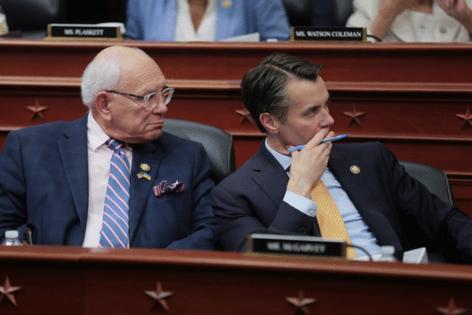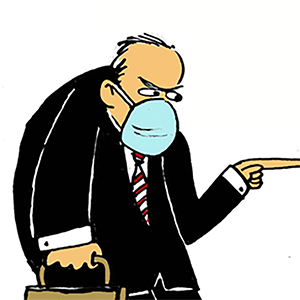Addiction, mental health agency eviscerated under Trump
Published in News & Features
WASHINGTON — The Trump administration’s plan to revamp the entire Health and Human Services Department, which Congress has rejected, has nevertheless led to the gutting of a 33-year-old agency that had been leading the nation’s response to the drug and mental health response epidemic.
Since February, staffing at the Substance Abuse and Mental Health Services Administration has shrunk by more than half to about 400 people, according to multiple sources. Many of its duties, assigned by Congress, have been given to a sister agency that primarily focuses on primary care, not substance use and mental health.
The damage to the agency, described in interviews with congressional staffers, former workers and health advocates, appears to line up with the Trump administration’s plan to reorganize the department, including the absorption of a much leaner SAMHSA and other subagencies into a newly created “Administration for a Healthy America.” That’s after Congress rejected such a plan as committees put together fiscal 2026 spending bills that have yet to become law.
The changes have raised concerns among lawmakers and activists who say the administration is upending the agency meant to lead the response to the substance use and mental health crises facing the United States.
“We are concerned by reports that the administration is taking steps to stop SAMHSA from serving its statutorily approved role as an independent agency,” Rep. Paul Tonko, D-N.Y., and five other members of Congress wrote in a letter in October to HHS Secretary Robert F. Kennedy Jr. “Let’s not forget that the whole reason Congress moved SAMHSA into an independent agency was to ensure that mental health and substance use disorder treatment was prioritized despite the longstanding stigma.”
SAMHSA, which is primarily a grant-making agency, doesn’t have the same name recognition as health care agencies like the Centers for Disease Control and Prevention, but the programs it administers touch the lives of millions of Americans.
“Cutting more capacity for the nation’s only mental health agency doesn’t improve the mental health of Americans,” said Hannah Wesolowski, chief advocacy officer for the National Alliance on Mental Illness. “I’m not sure how there’s going to be capacity across the agency to continue to deliver these grants and ensure accountability for grants.”
Employees don’t just administer funds. They provide technical assistance and guidance while ensuring grantees are pursuing the latest evidence-based approaches to substance use prevention and treatment.
The efforts appeared to be working, proponents say. Last year was the first drop in opioid overdose deaths in several years; about 80,000 people died of drug overdoses in 2024, a 27% drop from the year prior.
Many experts and advocates give credit, in part, to the work of the federal government and this agency, particularly for supporting treatment access and tools that help reduce the harms of drug use like naloxone, which reverses opioid overdoses.
“Here we have SAMHSA — an agency that has been incredibly successful helping to reduce overdose deaths significantly in the country … due in large part to the incredible promotion of community-based care,” said Paolo del Vecchio, who was director of SAMHSA’s Office of Recovery until he retired earlier this year. “What we see with Trump and RFK Jr. is dissolving the agency and proposing massive budget cuts to mental health and addiction services. This will make America sick again.”
Sidestepping Congress
Earlier this year, the Trump administration launched the plan to reorganize the department, which would cut several agencies and offices and fold them into the new Administration for a Healthy America. The president’s fiscal 2026 budget request suggested that several SAMHSA offices and grant programs administered by the agency should be eliminated.
Congress, which created the agency through legislation in 1992, has rejected those changes.
While the Trump administration requested funds to create the new Healthy America agency in its budget proposal, Congress is not looking to provide any funding, instead proposing to fund SAMHSA as it has for the past several decades. House appropriators, for example, approved fiscal 2026 spending legislation that would give it a $7.1 billion topline, even as the administration has worked to de-staff it.
Those appropriations bills have not yet passed their chambers amid the government shutdown stalemate.
Congress even passed a bill to reauthorize several SAMHSA grant programs focused on substance use treatment and prevention. The legislation would support many programs proposed for elimination by the administration that had been administered by offices that have essentially been eliminated or downsized.
Trump hasn’t signed the bill, which passed the House in June and cleared the Senate in September.
Still, the administration has moved forward with its plans. Pages within the HHS website refer to SAMHSA in the past tense. The administration did not create a budget justification for the agency, a standard document submitted to Congress each year to explain a budget request for the upcoming fiscal year. Instead, HHS submitted one for the new Administration for a Healthy America, with the forward written by Health Resources and Services Administrator Thomas J. Engels.
Al Guida, president and CEO of Guide Consulting Services, who lobbies on behalf of treatment providers and advocacy organizations, said his understanding is that the rolling of SAMHSA into the new entity is “an accomplished fact.”
“How do you run the programs with such small staff? I think the answer to that is you may not be able to do that,” he said. “And if you can’t do that, you can’t fulfill your statutory obligations given to that agency by Congress.”
States, lawmakers and grantees haven’t been able to get reliable information about what is happening, with some describing the lack of details as a “black hole.”
Grantees have been unable to make contact with employees who managed their grants and provided technical assistance, which can include helping design evidence-based programs and answer questions about grants’ permissible uses.
Nearly 10 months into his second term, President Donald Trump has not named an administrator for the agency. Its highest-level official, Principal Deputy Assistant Secretary Arthur Kleinschmidt, now reports to the Health Resources and Services Administration, according to sources. Several offices, including those for policy and communications, have also been transferred.
There are so few people left at SAMHSA, that HRSA employees are now administrating some of the grants, the sources say.
Amid the shrinking of the agency, most grants have gone out, though some later than expected. But many SAMHSA employees who issued those funds received layoff notices in early October. Congressional offices have said at least 125 employees at the agency got such notices.
“You have to have a project officer to administer grants, that’s the way the process is set up right now. At the present time, it may appear everything is running OK. It’s not,” said Wilson Washington, an employee who received a layoff notice.
Some grantees pull down funding monthly or quarterly.
“When the organization can’t pull down expenses, they’re going to have to shut down services and lay off some people … At some point, organizations won’t be able to pull down their funding,” said Washington, who is also president of the union representing SAMHSA bargaining unit workers.
Offices hit hard
Unions representing government workers have sued the administration over the notices, and some have received relief, including SAMHSA members represented by its union.
Still, a temporary restraining order to halt the layoffs only applies to reductions in force during the government shutdown, meaning those same workers could potentially be terminated when the government reopens.
SAMHSA’s Center for Mental Health Services, which leads the federal government’s efforts to promote the prevention and treatment of mental health conditions, was particularly hit hard in October, with 68 employees receiving layoff notices. That leaves 60 employees at the center, including public health service officers who cannot be fired.
The center manages more than 40 grant programs, covering about 2,500 efforts across the U.S. The terminations will leave the center’s Division of Children and School Mental Health with just one employee — a public health service officer who can’t be fired.
The division was responsible for grant programs aimed at helping children with serious emotional disturbances or at risk of developing serious mental illness, including a project inspired by the Sandy Hook school shooting that left 20 children and six adults dead. Project AWARE aims to help teachers identify signs of mental illness.
It will now fall on remaining employees to administer those grants, but “there’s not enough hours of the day for staff to be able to do an adequate job managing this quantity of grants,” said del Vecchio, who also previously directed the Center for Mental Health Services.
Meanwhile, 24 employees at the Center for Substance Abuse Prevention, and 26 employees at the Center for Substance Abuse Treatment, received layoff notices.
That includes all five employees of the Children and Families Branch, which aimed to reduce substance use in pregnant and postpartum women, among other initiatives. Also essentially decimated were the Criminal Justice Branch, which funds substance use treatment in drug courts.
The reductions in force eliminated the Division of Pharmacologic Therapies, which oversees regulations related to medication-assisted treatment for substance use disorders, and the Provider Support Branch, which helps educate health providers about best practices for substance use disorder treatment.
The Division of Pharmacologic Therapies last year overhauled methadone clinic regulations, which included allowing more take-home doses for the medicine which traditionally had to be obtained from a clinic in person several days a week.
“If these RIFs stand, once the government opens again, there will be fewer people and fewer experts who are able to oversee and provide support to grantees,” said Yngvild Olsen, who directed the Center for Substance Abuse Treatment until July and is now national adviser with Manatt Health.
Olsen said that if work with states and community-based organizations around naloxone distribution and expanding access to medications for opioid use disorder is compromised, “there is a risk that the positive impact we’ve seen in terms of reducing overdoses and getting people into treatment is potentially threatened.”
SAMHSA was also hit hard with layoffs in April, losing all 10 regional offices and the Office of Treatment Services.
©2025 CQ-Roll Call, Inc., All Rights Reserved. Visit cqrollcall.com. Distributed by Tribune Content Agency, LLC.







Comments